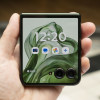Review: Samsung Flight II
The Samsung Flight II is a compact messaging phone, rounded on all corners. It's a little thick at a half inch, but it's actually shorter than the original Flight, and a bit thinner than the Pantech Pursuit, a comparable phone in AT&T's quick messaging lineup. The phone features a 2.8-inch, capacitive touchscreen up front, with Send, End and Back buttons just beneath the screen. A fairly generous, 4-row QWERTY keyboard slides out to the left. The phone is mostly grey plastic all over, with a few polished metal circles that ring the back button, the headset port and the camera. It's nondescript and unexciting, but it still looks modern. The rounded corners make the phone easy to hold during conversations. It might not fit into a tight pair of pants, but the Flight II has lost some weight since its predecessor, more than an ounce shaved off, so it didn't weigh me down.
The keyboard is nice for a simple messaging device. Each key has a slight hump and a small bit of space to separate them from the next letter. The layout is balanced with no funky breaks in the familiar QWERTY design. Letters take up the top three rows and the bottom row is devoted to symbols, which means you won't have to use the Fn key too much, even while entering Web and email addresses. The @ symbol is somewhat hidden, buried in the lower right corner, but it's paired with a .com key, a wise choice, and once I memorized their placement, I actually found this arrangement convenient. Still, I type @ more than I use an exclamation point, so maybe the ! doesn't need its own key. The keyboard has a shortcut key to create a new text message. Unfortunately, this key only works when you're looking at the home screen panels, not while you're browsing the menus or using a different feature on the phone. If I have to take multiple steps to use a shortcut, it isn't much of a shortcut, is it? Another minor complaint: the B key is too close to the 8 key. At a quick glance, I often mixed up the two.
On the left side of the phone is a volume rocker, nicely raised against the side of the device. The volume keys stick out more than any other key, which makes them easier to find. There's also an app switcher key on this side. On the right side, you'll find the camera button. It's a simple one-stage button, since the 2-megapixel camera on the Flight II does not use auto focus. There's also a screen lock key. You can hold down the lock key or hold your finger down on a button on screen to unlock the phone, but either way it always seemed to take too long to jump into the action.
Just above the lock key is the microUSB port, hidden behind a cover. It's too bad the Flight II didn't get the sliding port cover Samsung is using on its smartphones, because I prefer that design. Up top, you'll find a standard, 3.5mm headset jack, so you can use your favorite earbuds with this phone. The phone has a microSD card slot hidden beneath the battery cover, but not beneath the battery itself. The cover is easy to pry loose, so this isn't any trouble.











 Samsung Makes Eternity II and Flight II Official for AT&T
Samsung Makes Eternity II and Flight II Official for AT&T
 Samsung Flight II SGH-A927 Headed to AT&T
Samsung Flight II SGH-A927 Headed to AT&T
 Samsung Refines its Foldable Phones
Samsung Refines its Foldable Phones
 iPhone 14 Plus Offers a Big Screen For Less
iPhone 14 Plus Offers a Big Screen For Less
 Hands On with the Motorola razr and razr+ (2024)
Hands On with the Motorola razr and razr+ (2024)
 Samsung Flight II
Samsung Flight II



